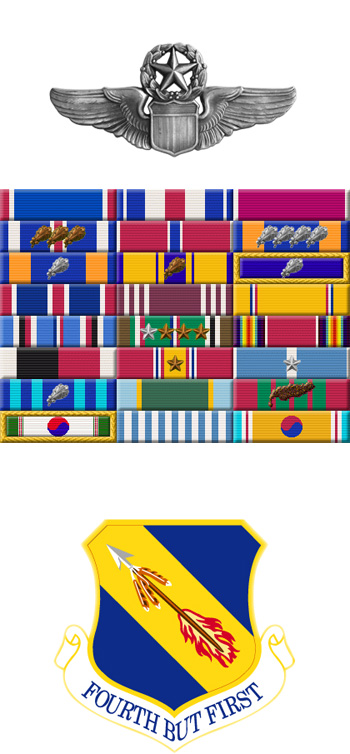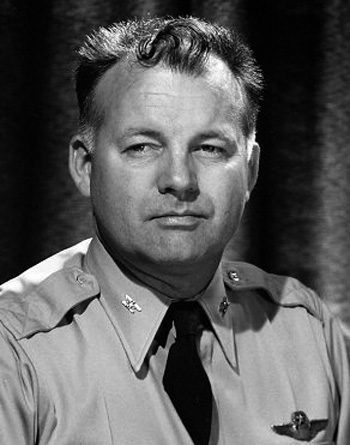
|
Glenn T. Eagleston |
 |
|||
| Rank, Service | ||||
Colonel O-6, U.S. Air Force |
||||
| Veteran of: | ||||
|
||||
| Tribute: | ||||
Glenn Eagleston was born on March 12, 1921, in Utah. He enlisted in the U.S. Army Air Corps on August 8, 1940, and entered the Aviation Cadet Program on January 31, 1942. Eagleston was commissioned a 2LT and awarded his pilot wings on September 29, 1942, and was assigned to the 79th Fighter Squadron of the 20th Fighter Group, flying the P-39 Airacobra from September 1942 to January 1943. He then transferred to the 353rd Fighter Squadron of the 354th Fighter Group and deployed with that Group to England in October 1943, flying P-51 Mustangs. Maj Eagleston was made commander of the 353rd Fighter Squadron in October 1944 and deputy commander of the 354th Fighter Group in May 1945. He returned from Europe in October 1945. During World War II, Maj Eagleston was credited with the destruction of 18.5 enemy aircraft in aerial combat. He served as assistant director of operations and training at Dover Field, Delaware, from February to June 1946, and then as commander of Dow Field, Maine, from July to September 1946. Col Eagleston completed Jet Fighter Pilot School at Williams Field, Arizona, in January 1947, and then served at Newark, New Jersey, until February 1949. He served as Operations Officer for the 33rd Fighter Group at Otis AFB, Massachusetts, from February to July 1949, and then attended Air Command and Staff School at Maxwell AFB, Alabama, from July 1949 to January 1950. He was then made commander of the 60th Fighter Squadron at Otis AFB, where he served until November 1950, when he became commander of the 334th Fighter Interceptor Squadron in Korea. Col Eagleston became commander of the 4th Fighter Interceptor Group in May 1951, and he returned to the United States in September 1951. During the Korean War, he added 2 aerial victory credits to his record, bringing his two-war total to 20.5 enemy aircraft destroyed in aerial combat. He next served as commander of the 103rd Fighter Interceptor Group and then Deputy Base Commander at Suffolk County AFB, New York, from September 1951 to April 1952. He was Director of Operations and Training at Headquarters Eastern Air Defense Force at Stewart AFB, New York, from April 1952 to October 1953, when he became commander of the 4750th Training Group at Vincent AFB, Arizona. Eagleston became Deputy Commander of the 4750th Air Defense Wing, also at Vincent AFB, in June 1955, and then served as Director of Operations of the 313th Air Division followed by duty as commander of the 6313th Air Base Wing, both at Kadena AB, Okinawa, until July 1960. He was next made Base Commander for the 4756th Air Base Group at Tyndall AFB, Florida, where he served from July 1960 to April 1962. This was followed by duty as Deputy Commander and then Commander of the 2478th AFRS at Long Beach Municipal Airport, California, from April 1962 to July 1965, when he was made Director of Maintenance for the 25th Air Division at McChord AFB, Washington. His final assignment was as Director of Material for Seattle Air Defense Sector at McChord AFB, from February 1966 until his retirement from the Air Force on February 28, 1967. Glenn Eagleston died on May 7, 1991. |
||||
|
||||

